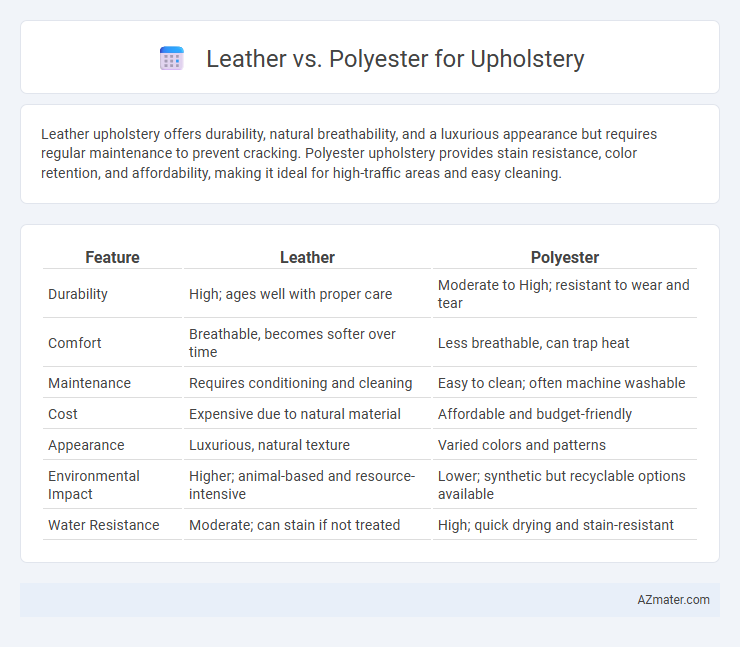Leather upholstery offers durability, natural breathability, and a luxurious appearance but requires regular maintenance to prevent cracking. Polyester upholstery provides stain resistance, color retention, and affordability, making it ideal for high-traffic areas and easy cleaning.
Table of Comparison
| Feature | Leather | Polyester |
|---|---|---|
| Durability | High; ages well with proper care | Moderate to High; resistant to wear and tear |
| Comfort | Breathable, becomes softer over time | Less breathable, can trap heat |
| Maintenance | Requires conditioning and cleaning | Easy to clean; often machine washable |
| Cost | Expensive due to natural material | Affordable and budget-friendly |
| Appearance | Luxurious, natural texture | Varied colors and patterns |
| Environmental Impact | Higher; animal-based and resource-intensive | Lower; synthetic but recyclable options available |
| Water Resistance | Moderate; can stain if not treated | High; quick drying and stain-resistant |
Introduction to Upholstery Materials
Leather upholstery offers durability, natural breathability, and a luxurious feel, making it ideal for high-end furniture in both residential and commercial settings. Polyester, a synthetic fabric, provides stain resistance, ease of maintenance, and affordability, often chosen for casual or high-traffic environments. Understanding the unique properties of leather and polyester helps in selecting upholstery materials that balance aesthetics, comfort, and longevity.
Overview of Leather Upholstery
Leather upholstery offers exceptional durability, natural breathability, and a sophisticated aesthetic that enhances any interior design. Its unique grain structure provides comfort and ages gracefully, developing a rich patina over time. Ideal for high-traffic areas, genuine leather resists wear and stains better than many synthetic alternatives, maintaining its luxurious appearance with proper care.
Overview of Polyester Upholstery
Polyester upholstery offers a durable and cost-effective alternative to leather, known for its resistance to stains, fading, and stretching. It is a synthetic fabric made from petroleum-based fibers that provides excellent color retention and easy maintenance, making it ideal for high-traffic areas. Its versatility in texture and design options allows for a wide range of aesthetic choices in furniture customization.
Durability Comparison: Leather vs Polyester
Leather upholstery offers exceptional durability with natural resistance to wear, punctures, and fading, making it ideal for high-traffic areas and long-term use. Polyester upholstery provides good durability with stain resistance, color retention, and resistance to abrasion, though it may not withstand rough usage as effectively as leather. Over time, leather tends to develop a patina that enhances its aesthetic, while polyester may show signs of wear such as pilling or fading under heavy use.
Comfort and Aesthetic Appeal
Leather upholstery offers a luxurious, supple texture that enhances comfort and ages gracefully with a unique patina, while polyester provides a soft, breathable fabric that resists wrinkles and stains for easy maintenance. Leather's natural material often brings a sophisticated, timeless aesthetic suited for elegant interiors, whereas polyester upholstery allows for a wide range of colors and patterns that complement modern and casual decor styles. Both materials balance durability and style, but leather provides a premium feel, while polyester excels in versatility and affordability.
Maintenance and Cleaning Requirements
Leather upholstery demands regular conditioning and prompt cleaning with specialized leather cleaners to prevent cracking and maintain its natural oils. Polyester fabric offers easier maintenance, allowing for simple vacuuming and spot cleaning with mild detergents, making it more resistant to stains and fading. Both materials require specific care routines, but polyester generally supports more hassle-free upkeep in high-traffic areas.
Cost Analysis: Leather vs Polyester
Leather upholstery typically demands a higher upfront investment, with costs ranging from $100 to $250 per yard, reflecting its durability and premium feel. Polyester upholstery offers a more budget-friendly option, averaging $20 to $60 per yard, making it ideal for cost-conscious projects. Maintenance expenses for leather may be higher due to specialized cleaning, while polyester's resilience reduces long-term upkeep costs.
Allergy and Environmental Impact
Leather upholstery is naturally hypoallergenic, resisting dust mites and pet dander, making it suitable for allergy sufferers, while polyester can trap allergens in its fibers, potentially aggravating sensitivities. Leather's production involves animal agriculture and tanning chemicals that contribute to environmental concerns, whereas polyester, a synthetic fabric derived from petroleum, poses challenges due to its non-biodegradability and microplastic pollution. Choosing leather offers durability with allergy benefits but higher ecological costs, while polyester provides affordability and versatility with increased allergy risks and environmental impact.
Popular Applications and Trends
Leather remains a top choice for high-end upholstery in luxury vehicles, executive office chairs, and premium residential furniture due to its durability, timeless elegance, and natural breathability. Polyester, favored in commercial spaces, hospitality settings, and budget-friendly home decor, offers versatility with stain resistance, easy maintenance, and a wide range of color options. Current trends show a growing preference for eco-friendly, vegan leather alternatives derived from polyester blends, combining sustainability with aesthetic appeal in upholstery design.
Which Upholstery Material is Best for You?
Leather offers durability, natural breathability, and a luxurious appearance, making it ideal for high-traffic areas and style-conscious spaces. Polyester provides affordability, stain resistance, and a wide range of colors and patterns, perfect for families or pets needing easy maintenance. Choosing the best upholstery material depends on balancing comfort, durability, budget, and aesthetic preferences in your living environment.

Infographic: Leather vs Polyester for Upholstery
 azmater.com
azmater.com